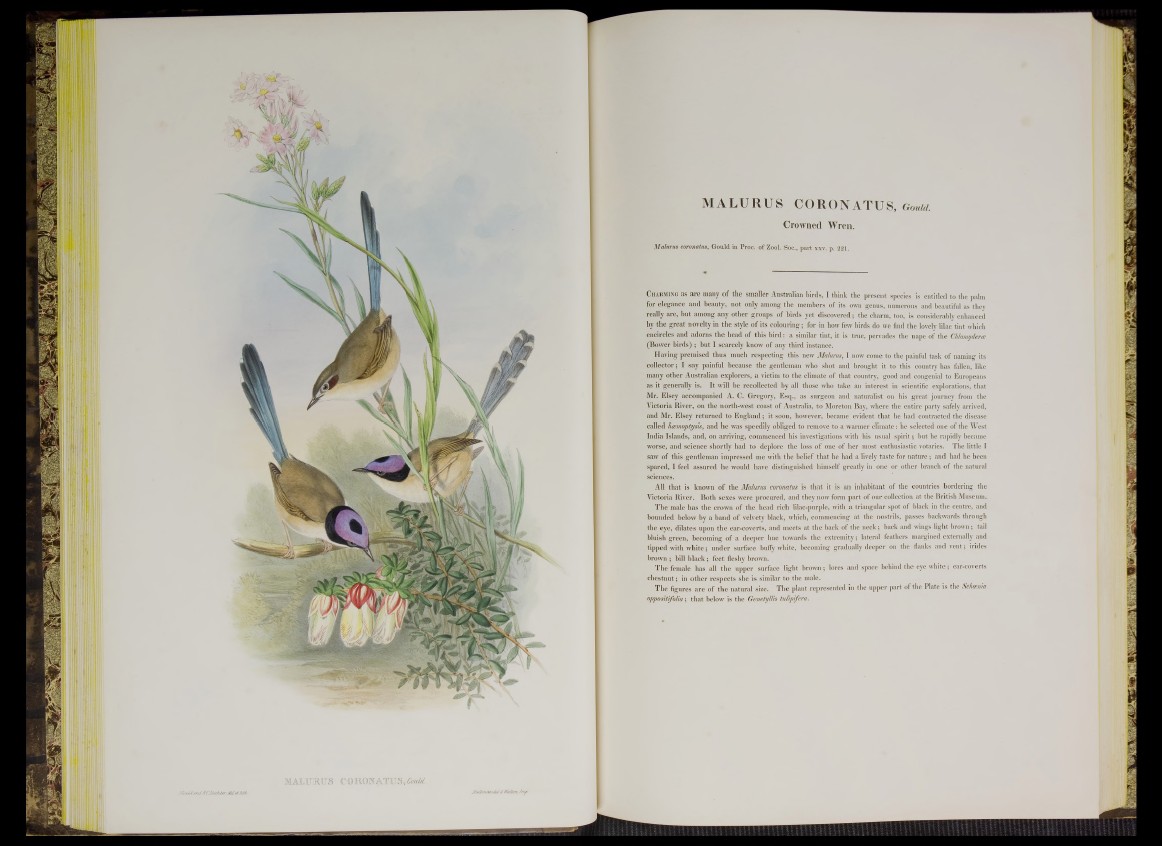
MALURUS CORONATUS, Gould.
Crowned Wren.
Malurus coronatus, Gould in Proc. of Zool. Soc., part xxv. p. 221.
C h armin g as are many of the smaller Australian birds, I think the present species is entitled to the palm
for elegance and beauty, not only among the members of its own genus, numerous and beautiful as they
really are, but among any other groups of birds yet discovered; the charm, too, is considerably enhanced
by the great novelty in the style of its colouring; for in how few birds do we find the lovely lilac tint which
encircles and adorns the head of this b ird : a similar tint, it is true, pervades the nape of the Chlamyderce
(Bower birds) ; but I scarcely know of any third instance.
Having premised thus much respecting this new Malurus, I now come to the painful task of naming its
collector; I say painful because the gentleman who shot and brought it to this country has fallen, like
many other Australian explorers, a victim to the climate of that country, good and congenial to Europeans
as it generally is. It will be recollected by all those who take an interest in scientific explorations, that
Mr. Elsey accompanied A. C. Gregory, Esq., as surgeon and naturalist on his great journey from the
Victoria River, on the north-west coast of Australia, to Moreton Bay, where the entire party safely arrived,
and Mr. Elsey returned to England; it soon, however, became evident that he had contracted the disease
called hemoptysis, and he was speedily obliged to remove to a warmer climate: he selected one of the West
India Islands, and, on arriving, commenced his investigations with his usual spirit; but he rapidly became
worse, and science shortly had to deplore the loss of one of her most enthusiastic votaries. The little I
saw of this gentleman impressed me with the belief that he had a lively taste for nature; and had lie been
spared, I feel assured he would have distinguished himself greatly in one or other branch of the natural
sciences.
All that is known of the Malurus coronatus is that it is an inhabitant of the countries bordering the
Victoria River. Both sexes were procured, and they now form part of our collection at the British Museum-
The male has the crown of the head rich lilac-purple, with a triangular spot of black in the centre, and
bounded below by a band of velvety black, which, commencing at the nostrils, passes backwards through
the eye, dilates upon the ear-coverts, and meets at the back of the neck; back and wings light brown; tail
bluish green, becoming of a deeper hue towards the extremity; lateral feathers margined externally and
tipped with white; under surface buffy white, becoming gradually deeper on the flanks and vent; irides
brown ; bill black; feet fleshy brown.
The female has all the upper surface light brown; lores and space behind the eye white; ear-coverts
chestnut; in other respects she is similar to the male.
The figures are of the natural size. The plant represented in the upper part of the Plate is the Schema
oppositifolia; that below is the Genetyllis tulipifera.